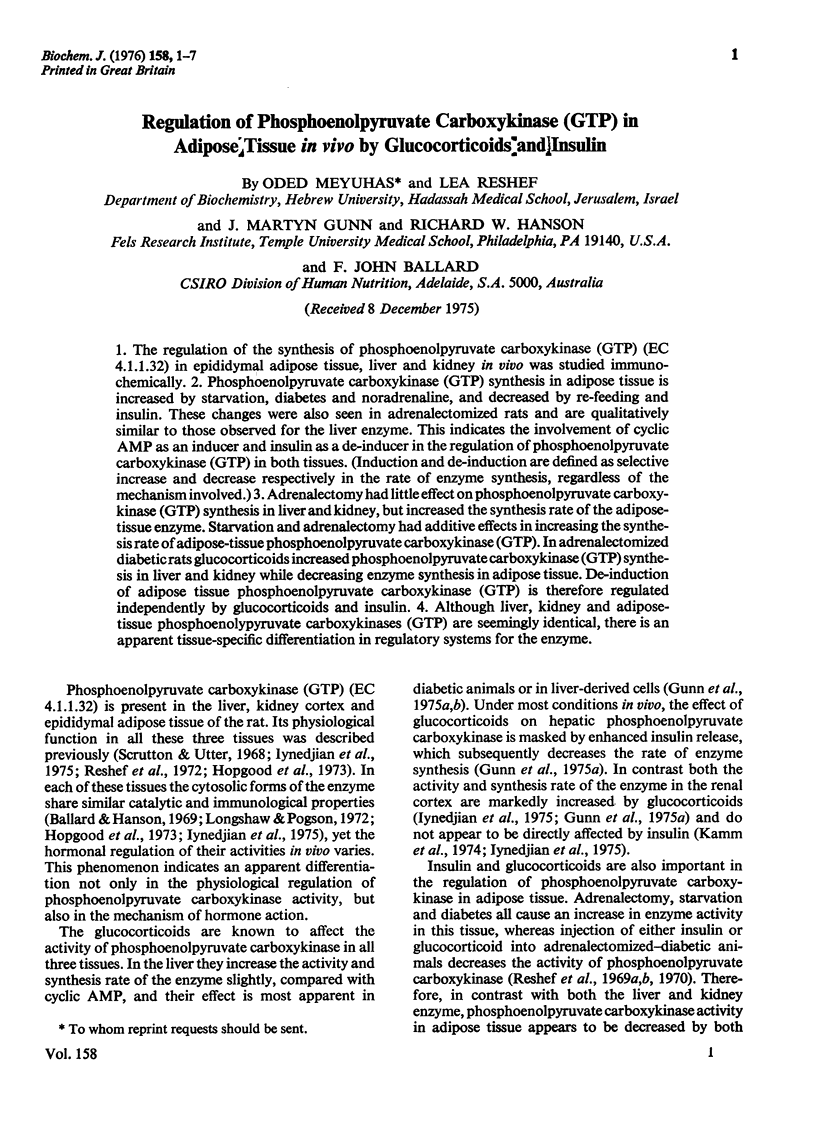Abstract
1. The regulation of the synthesis of phosphoenolpyruvate carboxykinase (GTP) (EC 4.1.1.32) in epididymal adipose tissue, liver and kidney in vivo was studied immunochemically. 2. Phosphoenolpyruvate carboxykinase (GTP) synthesis in adipose tissue is increased by starvation, diabetes and noradrenaline, and decreased by re-feeding and insulin. These changes were also seen in adrenalectomized rats and are qualitatively similar to those observed for the liver enzyme. This indicates the involvement of cyclic AMP as an inducer and insulin as a de-inducer in the regulation of phosphoenolpyruvate carboxykinase (GTP) in both tissues. (Induction and de-induction are defined as selective increase and decrease respectively in the rate of enzyme synthesis, regardless of the mechanism involved.)3. Adrenalectomy had little effect on phosphoenolpyruvate carboxykinase (GTP) synthesis in liver and kidney, but increased the synthesis rate of the adipose-tissue enzyme. Starvation and adrenalectomy had additive effects in increasing the synthesis rate of adipose-tissue phosphoenolpyruvate carboxykinase (GTP). In adrenalectomized diabetic rats glucocorticoids increased phosphoenolpyruvate carboxykinase (GTP) synthesis in liver and kidney while decreasing enzyme synthesis in adipose tissue. De-induction of adipose tissue phosphoenolpyruvate carboxykinase (GTP) is therefore regulated independently by glucocorticoids and insulin. 4. Although liver, kidney and adipose-tissue phosphoenolpyruvate carboxykinases (GTP) are seemingly identical, there is an apparent tissue-specific differentiation in regulatory systems for the enzyme.
Full text
PDF






Selected References
These references are in PubMed. This may not be the complete list of references from this article.
- Ballard F. J., Hanson R. W. Purification of phosphoenolpyruvate carboxykinase from the cytosol fraction of rat liver and the immunochemical demonstration of differences between this enzyme and the mitochondrial phosphoenolpyruvate carboxykinase. J Biol Chem. 1969 Oct 25;244(20):5625–5630. [PubMed] [Google Scholar]
- Gunn J. M., Hanson R. W., Meyuhas O., Reshef L., Ballard F. J. Glucocorticoids and the regulation of phosphoenolpyruvate carboxykinase (guanosine triphosphate) in the rat. Biochem J. 1975 Aug;150(2):195–203. doi: 10.1042/bj1500195. [DOI] [PMC free article] [PubMed] [Google Scholar]
- Gunn J. M., Tilghman S. M., Hanson R. W., Reshef L., Ballard F. J. Effects of cyclic adenosine monophosphate, dexamethasone and insulin on phosphoenolpyruvate carboxykinase synthesis in Reuber H-35 hepatoma cells. Biochemistry. 1975 Jun 3;14(11):2350–2357. doi: 10.1021/bi00682a012. [DOI] [PubMed] [Google Scholar]
- Hopgood M. F., Ballard F. J. Synthesis and degradation of phosphoenolpyruvate carboxylase in rat liver and adipose tissue. Changes during a starvation-re-feeding cycle. Biochem J. 1973 Jun;134(2):445–453. doi: 10.1042/bj1340445. [DOI] [PMC free article] [PubMed] [Google Scholar]
- Iynedjian P. B., Ballard F. J., Hanson R. W. The regulation of phosphoenolpyruvate carboxykinase (GTP) synthesis in rat kidney cortex. The role of acid-base balance and glucocorticoids. J Biol Chem. 1975 Jul 25;250(14):5596–5603. [PubMed] [Google Scholar]
- Kamm D. E., Strope G. L., Kuchmy B. L. Renal cortical and hepatic phosphoenolpyruvate carboxylase in the diabetic rat: effect of acid-base status. Metabolism. 1974 Nov;23(11):1073–1079. doi: 10.1016/0026-0495(74)90074-2. [DOI] [PubMed] [Google Scholar]
- Longshaw I. D., Alleyne G. A., Pogson C. I. The effect of steroids and ammonium chloride acidosis on phosphoenolpyruvate carboxykinase in rat kidney cortex. II. The kinetics of enzyme induction. J Clin Invest. 1972 Sep;51(9):2284–2291. doi: 10.1172/JCI107038. [DOI] [PMC free article] [PubMed] [Google Scholar]
- Longshaw I. D., Pogson C. I. The effect of steroids and ammonium chloride acidosis on phosphoenolpyruvate carboxykinase in rat kidney cortex. I. Differentiation of the inductive process and characterization of enzyme activities. J Clin Invest. 1972 Sep;51(9):2277–2283. doi: 10.1172/JCI107037. [DOI] [PMC free article] [PubMed] [Google Scholar]
- MUNCK A. Studies on the mode of action of glucocorticoids in rats. II. The effects in vivo and in vitro on net glucose uptake by isolated adipose tissue. Biochim Biophys Acta. 1962 Feb 26;57:318–326. doi: 10.1016/0006-3002(62)91125-3. [DOI] [PubMed] [Google Scholar]
- Meyuhas O., Reshef L., Ballard F. J., Hanson R. W. The effect of insulin and glucocorticoids on the synthesis and degradation of phosphoenolpyruvate carboxykinase (GTP) in rat adipose tissue cultured in vitro. Biochem J. 1976 Jul 15;158(1):9–16. doi: 10.1042/bj1580009. [DOI] [PMC free article] [PubMed] [Google Scholar]
- Reshef L., Ballard F. J., Hanson R. W. The role of the adrenals in the regulation of phosphoenolpyruvate carboxykinase of rat adipose tissue. J Biol Chem. 1969 Oct 25;244(20):5577–5581. [PubMed] [Google Scholar]
- Reshef L., Hanson R. W., Ballard F. J. A possible physiological role for glyceroneogenesis in rat adipose tissue. J Biol Chem. 1970 Nov 25;245(22):5979–5984. [PubMed] [Google Scholar]
- Reshef L., Hanson R. W., Ballard F. J. Glyceride-glycerol synthesis from pyruvate. Adaptive changes in phosphoenolpyruvate carboxykinase and pyruvate carboxylase in adipose tissue and liver. J Biol Chem. 1969 Apr 25;244(8):1994–2001. [PubMed] [Google Scholar]
- Reshef L., Hanson R. W. The interaction of catecholamines and adrenal corticosteroids in the induction of phosphopyruvate carboxylase in rat liver and adipose tissue. Biochem J. 1972 May;127(5):809–818. doi: 10.1042/bj1270809. [DOI] [PMC free article] [PubMed] [Google Scholar]
- Reshef L., Meyuhas O., Boshwitz C., Hanson R. W., Ballard F. J. Physiological role and regulation of glyceroneogenesis in rat adipose tissue. Isr J Med Sci. 1972 Mar;8(3):372–381. [PubMed] [Google Scholar]
- Tilghman S. M., Gunn J. M., Fisher L. M., Hanson R. W. Deinduction of phosphoenolpyruvate carboxykinase (guanosine triphosphate) synthesis in Reuber H-35 cells. J Biol Chem. 1975 May 10;250(9):3322–3329. [PubMed] [Google Scholar]
- Tilghman S. M., Hanson R. W., Reshef L., Hopgood M. F., Ballard F. J. Rapid loss of translatable messenger RNA of phosphoenolpyruvate carboxykinase during glucose repression in liver. Proc Natl Acad Sci U S A. 1974 Apr;71(4):1304–1308. doi: 10.1073/pnas.71.4.1304. [DOI] [PMC free article] [PubMed] [Google Scholar]


